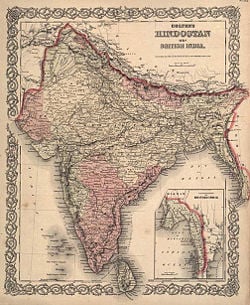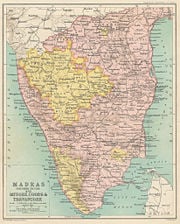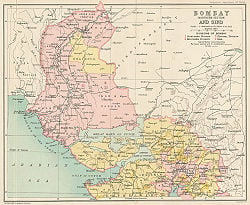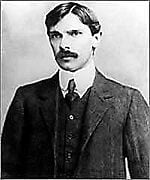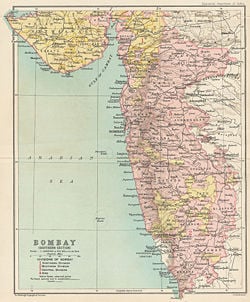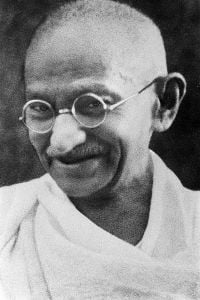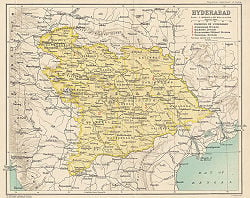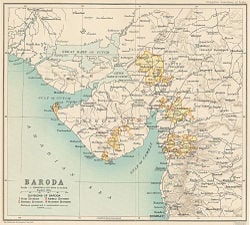45 British Imperialism in Asia
British Raj (rāj, lit. “rule” in Hindi) or British India, officially the British Indian Empire, and internationally and contemporaneously, India, is the term used synonymously for the region, the rule, and the period, from 1858 to 1947, of the British Empire on the Indian subcontinent. The region included areas directly administered by the United Kingdom[1] (contemporaneously, “British India”) as well as the princely states ruled by individual rulers under the paramountcy of the British Crown. Prior to 1858, Britain’s interests and possessions in India had been administered by the British East India Company, which was officially a commercial enterprise chartered by the Government. It operated in India as an agent of the Moghul Empire. After the First War of Indian Independence (known as the mutiny) the British government assumed direct responsibility for ruling its Indian territories. A policy of expansion followed that brought the whole of India within the Empire. The princely states, of which all entered into treaty arrangements with the British Crown, were allowed a degree of local autonomy in exchange for accepting protection and complete representation in international affairs by the United Kingdom.
Definition and Geographical Expanse
The British Indian Empire included the regions of present-day India, Pakistan, and Bangladesh, and, in addition, at various times, Aden (from 1858 to 1937), Lower Burma (from 1858 to 1937), Upper Burma (from 1886 to 1937) (Burma was detached from British India in 1937), British Somaliland (briefly from 1884 to 1898), and Singapore (briefly from 1858 to 1867). British India had some ties with British possessions in the Middle East; the Indian rupee served as the currency in many parts of that region. What is now Iraq was, immediately after World War I, administered by the India Office of the British government. The Indian Empire, which issued its own passports, was commonly referred to as India both in the region and internationally. As India, it was a founding member of the League of Nations, and a member nation of the Summer Olympics in 1900, 1920, 1928, 1932, and 1936. Among other countries in the region, Ceylon (now Sri Lanka), which was ceded to the United Kingdom in 1802 under the Treaty of Amiens, was a British Crown Colony, but not part of British India. The kingdoms of Nepal and Bhutan although having been in conflict with Britain, had both subsequently signed treaties with Britain, and were recognized as independent states and not part of the British Raj[2][3] The Kingdom of Sikkim was established as a princely state after the Anglo-Sikkimese Treaty of 1861, however, the issue of sovereignty was left undefined.[4] The Maldive Islands were a British protectorate from 1867 to 1965, but not part of British India.
The system of governance lasted from 1858, when the rule of the British East India Company was transferred to the Crown in the person of Queen Victoria (and who, in 1877, was proclaimed Empress of India), until 1947, when the British Indian Empire was partitioned into two sovereign states, the Dominion of India (later the Republic of India) and the Dominion of Pakistan (later the Islamic Republic of Pakistan and the People’s Republic of Bangladesh). Burma was separated from the administration of the British Indian Empire in 1937 and directly administered thereafter; it received independence from the UK in 1948 as the Union of Burma.
History
Company rule in India
On December 31, 1600 Queen Elizabeth I of England granted a royal charter to the British East India Company to carry out trade with the East. Ships first arrived in India in 1608, docking at Surat in modern-day Gujarat. Four years later, British traders battled the Portuguese at the Battle of Swally, gaining the favor of the Mughal emperor Jahangir in the process. In 1615, King James I sent Sir Thomas Roe as his ambassador to Jahangir’s court, and a commercial treaty was concluded in which the Mughals allowed the Company to build trading posts in India in return for goods from Europe. The Company traded in such commodities as cotton, silk, saltpetre, indigo, and tea.
By the mid-1600s, the Company had established trading posts or “factories” in major Indian cities, such as Bombay, Calcutta, and Madras in addition to their first factory at Surat (built in 1612). In 1670 King Charles II granted the company the right to acquire territory, raise an army, mint its own money, and exercise legal jurisdiction in areas under its control.
By the last decade of the seventeenth century, the Company was arguably its own “nation” on the Indian subcontinent, possessing considerable military might and ruling the three presidencies.
The British first established a territorial foothold in the Indian subcontinent when Company-funded soldiers commanded by Robert Clive defeated the Nawab of Bengal – Siraj Ud Daulah at the Battle of Plassey in 1757. Bengal became a British protectorate directly under the rule of the East India Company. Bengal’s wealth then flowed to the Company, which attempted to enforce a monopoly on Bengali trade (though smuggling was rife). Bengali farmers and craftsmen were obliged to render their labor for minimal remuneration while their collective tax burden increased greatly. Some believe that as a consequence, the famine of 1769-1773 cost the lives of ten million Bengalis[5]. A similar catastrophe occurred almost a century later, after Britain had extended its rule across the Indian subcontinent, when 40 million Indians perished from famine. The Company, despite the increase in trade and the revenues coming in from other sources, found itself burdened with massive military expenditures, and its destruction seemed imminent.
Building the Raj: British expansion across India
Lord North’s India Bill, The Regulating Act of 1773, by the British Parliament granted Whitehall, the British government administration, supervisory (regulatory) control over the work of the East India Company but did not take power for itself. This was the first step along the road to government control of India. It also established the post of Governor-General of India, the first occupant of which was Warren Hastings. Further acts, such as the Charter Act of 1813 and the Charter Act of 1833, further defined the relationship of the Company and the British government.
Hastings remained in India until 1784 and was succeeded by Cornwallis, who initiated the Permanent Settlement, whereby an agreement in perpetuity was reached with zamindars or landlords for the collection of revenue. For the next 50 years, the British were engaged in attempts to eliminate Indian rivals.
At the turn of the nineteenth century, Governor-General Lord Wellesley (brother of the Arthur Wellesley, 1st Duke of Wellington) began expanding the Company’s domain on a large scale, defeating Tippu Sultan (also spelled Tippoo Sultan), annexing Mysore in southern India, and removing all French influence from the subcontinent. In the mid-nineteenth century, Governor-General Lord Dalhousie launched perhaps the Company’s most ambitious expansion, defeating the Sikhs in the Anglo-Sikh Wars (and annexing the Punjab with the exception of the Phulkian States) and subduing Burma in the Second Burmese War. He also justified the takeover of small princely states such as Satara, Sambalpur, Jhansi, and Nagpur by way of the doctrine of lapse, which permitted the Company to annex any princely state whose ruler had died without a male heir. The annexation of Oudh in 1856 proved to be the Company’s final territorial acquisition, as the following year saw the boiling over of Indian grievances toward the so-called “Company Raj.”
First War of Indian Independence
On May 10, 1857 soldiers of the British Indian Army (known as “sepoys,” from Urdu/Persian sipaahi = “soldier”), drawn from the Indian Hindu and Muslim population, rose against British in Meerut, a cantonment 65 kilometres northeast of Delhi. At the time, the strength of the Company’s Army in India was 238,000, of whom 38,000 were Europeans. Indian soldiers marched to Delhi to offer their services to the Mughal emperor, and soon much of north and central India was plunged into a year-long insurrection against the British East India Company. Many Indian regiments and Indian kingdoms joined the uprising, while other Indian units and Indian kingdoms backed the British commanders and the HEIC.
Causes of the rebellion
The rebellion or the war for independence had diverse political, economic, military, religious and social causes.
The policy of annexation pursued by Governor-General Lord Dalhousie, based mainly on his “Doctrine of Lapse,” which held that princely states would be merged into company-ruled territory in case a ruler died without direct heir. This denied the Indian rulers the right to adopt an heir in such an event; adoption had been pervasive practice in the Hindu states hitherto, sanctioned both by religion and by secular tradition. The states annexed under this doctrine included such major kingdoms as Satara, Thanjavur, Sambhal, Jhansi, Jetpur, Udaipur, and Baghat. Additionally, the company had annexed, without pretext, the rich kingdoms of Sind in 1843 and Oudh in 1856, the latter a wealthy princely state that generated huge revenue and represented a vestige of Mughal authority. This greed for land, especially in a group of small-town and middle-class British merchants, whose parvenu background was increasingly evident and galling to Indians of rank, had alienated a large section of the landed and ruling aristocracy, who were quick to take up the cause of evicting the merchants once the revolt was kindled.
The justice system was considered inherently unfair to the Indians. The official Blue Books — entitled East India (Torture) 1855–1857 — that were laid before the House of Commons during the sessions of 1856 and 1857 revealed that Company officers were allowed an extended series of appeals if convicted or accused of brutality or crimes against Indians.
The economic policies of the East India Company were also resented by the Indians. Most of the gold, jewels, silver and silk had been shipped off to Britain as tax and sometimes sold in open auctions, ridding India of its once abundant wealth in precious stones. The land was reorganized under the comparatively harsh Zamindari system to facilitate the collection of taxes. In certain areas farmers were forced to switch from subsistence farming to commercial crops such as indigo, jute, coffee and tea. This resulted in hardship to the farmers and increases in food prices. Local industry, specifically the famous weavers of Bengal and elsewhere, also suffered under British rule. Import tariffs were kept low, according to traditional British free-market sentiments, and thus the Indian market was flooded with cheap clothing from Britain. Indigenous industry simply could not compete, and where once India had produced much of England’s luxury cloth, the country was now reduced to growing cotton which was shipped to Britain to be manufactured into clothing, which was subsequently shipped back to India to be purchased by Indians. This extraordinary quantity of wealth, much of it collected as ‘taxes’, was absolutely critical in expanding public and private infrastructure in Britain and in financing British expansionism elsewhere in Asia and Africa.
The spark that lit the fire was the result of a British blunder in using new cartridges for the Pattern 1853 Enfield rifle that were greased with animal fat, rumored to now be a combination of pig-fat and cow-fat. This was offensive to the religious beliefs of both Muslim and Hindu sepoys, who refused to use the cartridges and, under provocation, finally mutinied against their British officers.
The rebellion soon engulfed much of North India, including Oudh and various areas that had lately passed from the control of Maratha princes to the company. The unprepared British were terrified, without replacements for the casualties. However, after getting reinforcements, the British army was able to suppress the uprising and restore British control over these areas.
It was a monumental event in history, for both Indians and British alike. The Rebels had achieved (at that time) the impossible in uniting and overthrowing (if only temporarily) an apparently unbeatable army and a now semi-despotic ruling power. Heroic defenses of British bases such as the Siege of Lucknow, Siege of Cawnpore and the retaking of rebel held cities as in the Siege of Delhi also passed into history.
Isolated uprisings also occurred at military posts in the centre of the subcontinent. The last major sepoy rebels surrendered on June 21, 1858, at Gwalior (Madhya Pradesh), one of the principal centres of the revolt. A final battle was fought at Sirwa Pass on May 21, 1859, and the defeated rebels fled into Nepal.
Aftermath of the 1857 Rebellion and the formal initiation of the Raj
The rebellion was a major turning point in the history of modern India. In May 1858, the British exiled Emperor Bahadur Shah Zafar II (r. 1837–1857) to Rangoon, Burma (now Yangon, Myanmar), after executing most of his family, thus formally liquidating the Mughal Empire. Bahadur Shah Zafar, known as the Poet King, contributed some of Urdu‘s most beautiful poetry[6], with the underlying theme of the freedom struggle[7]. The Emperor was not allowed to return and died in solitary confinement in 1862. The Emperor’s three sons, also involved in the 1857 Rebellion, were arrested and shot in Delhi by Major William Stephen Raikes Hodson of the British Indian Army.
Cultural and religious centres were closed down, properties and estates of those participating in the uprising were confiscated. At the same time, the British abolished the British East India Company and replaced it with direct rule under the British Crown. In proclaiming the new direct-rule policy to “the Princes, Chiefs, and Peoples of India,” Queen Victoria (upon whom the British Parliament conferred the title “Empress of India” in 1877) promised equal treatment under British law, which never materialized.
Many existing economic and revenue policies remained virtually unchanged in the post-1857 period, but several administrative modifications were introduced, beginning with the creation in London of a cabinet post, the Secretary of State for India. The governor-general (called viceroy when acting as representative to the nominally sovereign “princely states” or “native states”), headquartered in Calcutta, ran the administration in India, assisted by executive and legislative councils. Beneath the governor-general were the governors of Provinces of India, who held power over the division and district officials, who formed the lower rungs of the Indian Civil Service. For decades the Indian Civil Service was the exclusive preserve of the British-born, as were the superior ranks in such other professions as law and medicine. This continued until the 1880s when a small but steadily growing number of native-born Indians, educated in British schools on the Subcontinent or in Britain, were able to assume such positions. However, a proposal by Viceroy Ripon and Courtenay Ilbert in 1883 that Indian members of the Civil Service have full rights to preside over trials involving white defendants in criminal cases sparked an ugly racist backlash. Thus an attempt to further include Indians in the system and give them a greater stake in the Raj, ironically, instead exposed the racial gap that already existed, sparking even greater Indian nationalism and reaction against British rule.
The Viceroy announced in 1858 that the government would honor former treaties with princely states and renounced the “Doctrine of Lapse,” whereby the East India Company had annexed territories of rulers who died without male heirs. About 40 percent of Indian territory and 20–25 percent of the population remained under the control of 562 princes notable for their religious (Islamic, Hindu, Sikh and other) and ethnic diversity. Their propensity for pomp and ceremony became proverbial, while their domains, varying in size and wealth, lagged behind socio-political transformations that took place elsewhere in British-controlled India. A more thorough re-organization was effected in the constitution of army and government finances. Shocked by the extent of solidarity among Indian soldiers during the rebellion, the government separated the army into the three presidencies. The Indian Councils Act of 1861 restored legislative powers to the Presidencies (elite provinces), which had been given exclusively to the governor-general by the Charter Act of 1833.
British attitudes toward Indians shifted from relative openness to insularity and racism, even against those with comparable background and achievement as well as loyalty. British families and their servants lived in cantonments at a distance from Indian settlements. Private clubs where the British gathered for social interaction became symbols of exclusivity and snobbery that refused to disappear decades after the British had left India. In 1883 the government of India attempted to remove race barriers in criminal jurisdictions by introducing a bill empowering Indian judges to adjudicate offences committed by Europeans. Public protests and editorials in the British press, however, forced the viceroy George Robinson, First Marquess of Ripon, (who served from 1880 to 1884), to capitulate and modify the bill drastically. The Bengali “Hindu intelligentsia” learned a valuable political lesson from this “white mutiny”: the effectiveness of well-orchestrated agitation through demonstrations in the streets and publicity in the media when seeking redress for real and imagined grievances.
Effects on economy
Some of the modernization associated with the industrial revolution did benefit India during this period. Foreign investors set up jute mills around Calcutta, and Indian merchants set up cotton textile factories in Gujrat and around Bombay. However, this was accompanied by the collapse of traditional industry, which was faced with the ferocious competition of cheap British-made goods. When the British arrived to India for trading, a prosperous India accounted for more than 17 percent of the world GDP, but when the British left India in 1947, it is believed that India accounted for less than one percent of the world Gross Domestic Product.
Post-1857 India also experienced a period of unprecedented calamity when the region was swept by a series of frequent and devastating famines, among the most catastrophic on record. Approximately 25 major famines spread through states such as Tamil Nadu in South India, Bihar in the north, and Bengal in the east in the latter half of the nineteenth century, killing 30–40 million Indians.
Contemporary observers of the famines such as Romesh Dutt as well as present-day scholars such as Amartya Sen attributed the famines both to uneven rainfall and British economic and administrative policies, which since 1857 had led to the seizure and conversion of local farmland to foreign-owned plantations, restrictions on internal trade, inflationary measures that increased the price of food, and substantial exports of staple crops from India to the United Kingdom [8][9][10][11]. On the other hand some other scholars have argued that, whilst the famines may have been exacerbated by British policy, they were primarily caused by drought and ecological factors.[12][13]
Some British citizens such as William Digby agitated for policy reforms and better famine relief, but Robert Bulwer-Lytton, 1st Earl of Lytton, son of the poet Edward Bulwer-Lytton, 1st Baron Lytton and the governing British viceroy in India, opposed such changes in the belief that they would stimulate shirking by Indian workers. The famines continued until independence in 1947, with the Bengal Famine of 1943–1944—among the most devastating—killing three–four million Indians during World War II. Famine relief methods were inefficient as they often involved making undernourished people do heavy labor on public works. However, there were some famines (ex. 1874 and 1907) in which English officials acted effectively. During the famine of 1897-1902 the Curzon administration spent £10,000,000 (money of the day) and at its peak 4,500,000 people were on famine relief. From the 1880s onwards British administrators built a series of irrigation canals in India, much of it for the purpose of famine prevention.[14] After 1902 there was not a single famine in India until 1943 in Bengal. ‘What the British added was above all the power of a unified an authoritarian state, which acted because it saw the danger of drought and famine to its rule’.[15]. After the major famines the British government conducted “serious investigations”[16] into the famine. Lord Lytton’s administration was particularly negligent when it came to famine relief, with disastrous results. It was Lord Lytton’s belief that market forces would see that food got into famine stricken areas, therefore government aid would not be necessary and in fact would inhibit famine relief efforts (Niall Ferguson, Empire and Lady Beatty Balfour, Lord Lytton’s Indian Administration). As a result of the calamity of 1877 Lord Lytton lost his job but not before he established the Famine Insurance Grant. The results of this was that the British prematurely assumed that the problem of famine had been solved forever[17]. This, sadly, proved not to be the case and the complacency that resulted from it contributed to the lack of action by the Elgin[18]. Curzon abhorred the seeming indifference many Britons at home had towards famine in India[19]. ‘It was the tragedy of 1876-1878 that led to the establishment of a general famine commission under Richard Strachey and the consequent adoption of a famine code’[20] A famine code was not adopted in Bengal however, which contributed to the disaster in 1943. In order to limit the effects of famine ‘’Successive British governments were anxious not to add to the burden of taxation”[21].
The twenty-first century Indian legal system, India’s governmental structure, the national capital, and the railway network (the world’s biggest employer) all remain substantially influenced by the British period. The predominance of the English language in India, has also proved to be a critical advantage for Indian tourism, call centres and computer software developers. As a direct result of former ties between the UK and India, substantial numbers of Indian nationals have been allowed to emigrate to the UK. For several decades this large community has imported Indian products to sell in the wider British market, has sent remittances home and has invested British earned capital in Indian business ventures.
Beginnings of self-government
The first steps were taken toward self-government in British India in the late 19th century with the appointment of Indian counsellors to advise the British viceroy and the establishment of provincial councils with Indian members; the British subsequently widened participation in legislative councils with the Indian Councils Act of 1892. Municipal Corporations and District Boards were created for local administration; they included elected Indian members.
The Government of India Act of 1909—also known as the Morley-Minto Reforms (John Morley was the secretary of state for India, and Gilbert Elliot, fourth earl of Minto, was viceroy)—gave Indians limited roles in the central and provincial legislatures, known as legislative councils. Indians had previously been appointed to legislative councils, but after the reforms some were elected to them. At the centre, the majority of council members continued to be government-appointed officials, and the viceroy was in no way responsible to the legislature. At the provincial level, the elected members, together with unofficial appointees, outnumbered the appointed officials, but responsibility of the governor to the legislature was not contemplated. Morley made it clear in introducing the legislation to the British Parliament that parliamentary self-government was not the goal of the British government.
The Morley-Minto Reforms were a milestone. Step by step, the elective principle was introduced for membership in Indian legislative councils. The “electorate” was limited, however, to a small group of upper-class Indians. These elected members increasingly became an “opposition” to the “official government.” Communal electorates were later extended to other communities and made a political factor of the Indian tendency toward group identification through religion.
Muhammad Ali Jinnah is credited for uniting Muslims to form the state of Pakistan.
For Muslims it was important both to gain a place in all-India politics and to retain their Muslim identity, objectives that required varying responses according to circumstances, as the example of Muhammed Ali Jinnah illustrates. Jinnah, who was born in 1876, studied law in England and began his career as an enthusiastic liberal in Congress on returning to India. In 1913 he joined the Muslim League, which had been shocked by the 1911 annulment of the partition of Bengal into cooperating with Congress to make demands on the British. Jinnah continued his membership in Congress until 1919. During this dual membership period, he was described by a leading Congress spokesperson, Mrs. Sarojini Naidu, as the “ambassador of Hindu-Muslim unity.”
After World War I
A number of factors influenced the evolution of the Raj’s India policy during and after World War I. Before and during the war, millitant movements had been on the rise, and during the war, massive efforts had been made by the Germans, along with expatriate Indian groups like Ghadar and the Berlin Committee to destabilize British India. During the war, the revolutionary movement in Bengal was significant enough to nearly paralyze the local administration. This militancy was, however, on its wane by the end of the war. Further, India’s important contributions to the efforts of the British Empire in World War I stimulated further expectations and demands within India for political progress, and found response from Montagu, the newly appointed and liberal Secretary of State for India. The Congress Party and the Muslim League met in joint session in December 1916. Under the leadership of Jinnah and Pandit Motilal Nehru (father of Jawaharlal Nehru), unity was preached and a proposal for constitutional reform was made that included the concept of separate electorates. The resulting Congress-Muslim League Pact [22] (often referred to as the Lucknow Pact) was a sincere effort to compromise. Congress accepted the separate electorates demanded by the Muslim League, and the Muslim League joined with Congress in demanding self-government. The pact was expected to lead to permanent and constitutional united action.
In August 1917 the British government formally announced a policy of “increasing association of Indians in every branch of the administration and the gradual development of self-governing institutions with a view to the progressive realization of responsible government in India as an integral part of the British Empire.” Constitutional reforms were embodied in the Government of India Act 1919, also known as the Montagu-Chelmsford Reforms (Edwin Samuel Montagu was the United Kingdom’s Secretary of State for India; the Viscount Chelmsford was viceroy). These reforms represented the maximum concessions the British were prepared to make at that time. The franchise was extended, and increased authority was given to central and provincial legislative councils, but the viceroy remained responsible only to London.
The changes at the provincial level were significant, as the provincial legislative councils contained a considerable majority of elected members. In a system called “dyarchy,” based on an approach developed by Lionel Curtis, the nation-building departments of government—agriculture, education, public works, and the like—were placed under ministers who were individually responsible to the legislature. The departments that made up the “steel frame” of British rule—finance, revenue, and home affairs—were retained by executive councillors who were often (but not always) British, and who were responsible to the governor. The act indirectly increased the number of elected Indian members in district boards and municipal corporations, since the authority to regulate local government bodies was placed in the hands of the popularly elected ministers, whose constituents naturally wanted more democracy. Later, tariff protection was finally given to Indian industry.
Mahatma Gandhi is largely credited for uniting Indians using passive resistance in their political struggle for independence from British rule.
The 1919 reforms did not satisfy political demands in India. The presence of Indian nationalists in Afghanistan and the remnants of the terrorist movements in Punjab and Bengal (which, unrealized by the Raj, was declining), along with popular unrest in the midst of economic depression in the post-war scenario (including strikes by mill workers in Bombay and similar labor unrests in the rest of the country) neccessitated the institution of the Rowlatt Commission to investigate the German and Bolshevik links to these unrests, especially in Punjab and Bengal. British repressed opposition and re-enacted restrictions on the press and on movement. An apparently unwitting example of violation of rules against the gathering of people led to the massacre at Jalianwala Bagh in Amritsar in April 1919. This tragedy galvanized such political leaders as Jawaharlal Nehru (1889 – 1964) and Mohandas Karamchand “Mahatma” Gandhi (1869 – 1948) and the masses who followed them to press for further action.
The Allies‘ post-World War I peace settlement with Turkey provided an additional stimulus to the grievances of the Muslims, who feared that one goal of the Allies was to end the caliphate of the Ottomansultan. After the end of the Mughal Empire, the Ottoman caliph had become the symbol of Islamic authority and unity to Muslims in the British Raj. A pan-Islamic movement, known as the Khilafat Movement, spread in India. It was a mass repudiation of Muslim loyalty to British rule and thus legitimated Muslim participation in the Indian nationalist movement. The leaders of the Khilafat Movement used Islamic symbols to unite the diverse but assertive Muslim community on an all-India basis and bargain with both Congress leaders and the British for recognition of minority rights and political concessions.
Muslim leaders from the Deoband and Aligarh movements joined Gandhi in mobilizing the masses for the 1920 and 1921 demonstrations of civil disobedience and non-cooperation in response to the massacre at Amritsar. At the same time, Gandhi endorsed the Khilafat Movement, thereby placing many Hindus behind what had been solely a Muslim demand.
Despite impressive achievements, however, the Khilafat Movement failed. Turkey rejected the caliphate and became a secular state. Furthermore, the religious, mass-based aspects of the movement alienated such Western-oriented constitutional politicians as Jinnah, who resigned from Congress. The movement was given a final blow when the Amir of Afghanistan closed off its borders and many of the participants of the Khilafat movement perished due to lack of food and exposure to the elements. Other Muslims also were uncomfortable with Gandhi’s leadership. The British historian Sir Percival Spear wrote that: “a mass appeal in his Gandhi‘s hands could not be other than a Hindu one. He could transcend Hindu caste but not community. The Hindu devices he used went sour in the mouths of Muslims”. In the final analysis, the movement failed to lay a lasting foundation of Indian unity and served only to aggravate Hindu-Muslim differences among masses that were being politicized. Indeed, as India moved closer to the self-government implied in the Montagu-Chelmsford Reforms, rivalry over what might be called the spoils of independence sharpened the differences between the communities.
World War II and the end of the Raj
Map of the Hyderabad State, 1909
By 1942, Indians were divided over World War II, as the British had unilaterally and without consultation entered India into the war. Some wanted to support the British during the Battle of Britain, believing the UK would keep its word of granting India independence once the war was won. Others were enraged by a believed British disregard for Indian intelligence and civil rights, and were unsympathetic to the travails of the British people. The British Indian army, with a strength of 2,250,000 by the end of the war, came to be the largest all-volunteer army in the history of the world. However, even during the war, in July 1942, the Indian National Congress had passed a resolution demanding complete independence from Britain. The draft proposed that if the British did not accede to the demands, massive civil disobedience would be launched. In August 1942 the Quit India Resolution was passed at the Bombay session of the All India Congress Committee (AICC) marking the start of what was the Quit India Movement. The movement was to see massive, and initially peaceful demonstrations and denial of authority, undermining the British War effort. Large-scale protests and demonstrations were held all over the country. Workers remained absent en masse and strikes were called. The movement also saw widespread acts of sabotage, Indian under-ground organization carried out bomb attacks on allied supply convoys, government buildings were set on fire, electricity lines were disconnected and transport and communication lines .were severed.
The movement soon became a leaderless act of defiance, with a number of acts that deviated from Gandhi’s principle of non-violence. In large parts of the country, the local underground organizations took over the movement. However, by 1943, Quit India had petered out.
However, at the time the war was at its bloodiest in Europe and Asia, the Indian revolutionary Subhash Chandra Bose had escaped from house arrest in Calcutta and ultimately made his way to Germany, and then to Japanese South Asia, to seek Axis help to raise an army to fight against the British control over India. Bose formed what came to be known as the Azad Hind Government as the Provisional Free Indian Government in exile, and organized the Indian National Army with Indian POWs and Indian expatriates in Southeast Asia with the help of the Japanese. Its aim was to reach India as a fighting force that would inspire public resentment and revolts within the Indian soldiers to defeat the Raj. The INA fought hard in the forests of Assam, Bengal and Burma, laying siege to Imphal and Kohima with the Japanese 15th Army. It would ultimately fail, owing to disrupted logistics, poor arms and supplies from the Japanese, and lack of support and training. However, Bose’s audacious actions and radical initiative energized a new generation of Indians.
Many historians have argued that it was the INA and the mutinies it inspired among the British Indian Armed forces that was the true driving force for India’s independence [23][24] [25]. The stories of the Azad Hind movement and its army that came to public attention during the trials of soldiers of the INA in 1945, were seen as so inflammatory that, fearing mass revolts and uprisings—not just in India, but across its empire—the British Government forbade the BBC to broadcast their story[26]. Newspapers reported at the time a summary execution of INA soldiers held at Red Fort[27]. During and after the trial, mutinies broke out in the British Indian Army, most notably in the Royal Indian Navy; these found public support throughout India, from Karachi to Bombay and from Vizag to Calcutta.
These revolts, faced by the weakened post-war Raj, coupled with the fact that the faith in the British Indian Armed forces had been lost, ultimately shaped the decision to end the Raj. By early 1946, all political prisoners had been released. British openly adopted a political dialogue with the Indian National Congress for the eventual independence of India. On 15 August 1947 the transfer of Power took place. At midnight on 14 August 1947 Pakistan (including modern Bangladesh) was granted independence. India was granted independence the following day.
Most people would give these dates as the end of the British Raj. However, some people argue that it continued until 1950 in India when it adopted a republican Constitution.
Literature
The Raj produced, and continues to inspire, a genre of literature in which the writing of Rudyard Kipling, E. M. Forster, John Masters and Paul Scott among others features prominently. Kipling more or less subscribed to the dominant attitude of superiority with his concept of the ‘white man’s burden,” other writers including Forster in A Passage to India exposed the hypocrisy and mean spiritedness of colonial rule. Such literature, together with the non-fiction work of Charles Allen, reveals the views and habits that the British developed in India, their preoccupation with precedence, their attitude towards servants especially and Indians generally and their attempt to replicate a British life-style in a very different environment. Usually, the British lived in isolation from Indian society. Marriage between British “other ranks” and Indians, though, did occur, producing the Anglo-Indian community. This is explored by Masters in his Bhowani Junction, and other works.
Assessment
Initially, many involved in the enterprise had a high regard for Indian culture and thought in terms of a partnership between Britain and India. Following the so-called Mutiny, attitudes changed. The British adopted more racially motivated attitudes, regarding Indians as incapable of self-government and their culture as inferior, if fascinating. Education in the medium of English, and Western curricula, was supported by the Government. Education aimed to produce a class of Indians named Macauley’s “minute men” (following Thomas Babington Macauley‘s Minute on Indian Education given February 2, 1835[28]) who, apart from their skin-color, would be English in taste, attitude and loyalty.
A moral rationale was developed to justify colonial rule based on the view that Britain’s responsibilities were those of a parent towards an immature child. Regular reports were presented to Parliament on the social and economic progress of India but some blame the more frequent famines that occurred on aspects of British policy, and suggest that the British response to these episodes also undermined their claim to occupy the moral high ground, as depicted in Rudyard Kipling‘s White Man’s Burden.[29]
Provinces
At the time of independence, British India consisted of the following provinces:
- Ajmer-Merwara-Kekri
- Andaman and Nicobar Islands
- Assam
- Baluchistan
- Bengal
- Bihar
- Bombay Province – Bombay
- Central Provinces and Berar
- Delhi Province – Delhi
- Madras Province – Madras
- North-West Frontier Province
- Panth-Piploda
- Orissa
- Punjab
- Sindh
- United Provinces (Agra and Oudh)
Eleven provinces (Assam, Bengal, Bihar, Bombay, Central Provinces, Madras, North-West Frontier, Orissa, Punjab, and Sindh) were headed by a governor. The remaining six (Ajmer Merwara, Andaman and Nicobar Islands, Baluchistan, Coorg, Delhi, and Panth-Piploda) were governed by a chief commissioner.
There were also several hundred Princely States, under British protection but ruled by native rulers. Among the most notable of these were Jaipur, Gwalior, Hyderabad, Mysore, Travancore and Jammu and Kashmir.

